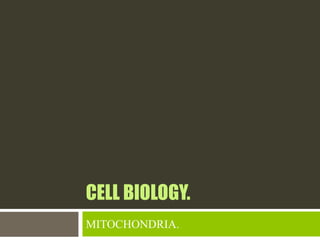Mitochondria
- 2. ANIMAL CELL â MITOCHONDRIA.
- 3. INTRODUCTION. ïĻ MITOCHONDRIA are important cell organelles, essential for aerobic respiration of eukaryotic cell. They are popularly called as âPOWER HOUSES OF CELLâ because they are the centre of release of energy. ïĻ Mitochondria was first observed by Kolliker in 1880.
- 4. Two mitochondria from mammalian lung tissue displaying their matrix and membranes as shown by electron microscopy.
- 5. LOCATION. ïĻ Mitochondria are found in nearly all eukaryotes. They vary in number and location according to cell type. ïĻ A single mitochondrion is often found in unicellular organisms. ïĻ Conversely, numerous mitochondria are found in human liver cells, with about 1000â2000 mitochondria per cell, making up 1/5 of the cell volume.
- 6. STRUCTURE. ïĻ The size & shape of mitochondria varies. They are small rod- shaped or spherical structures present in the cytoplasm of the cells which show aerobic respiration. The shape depends upon the physiological condition of the cell. ïĻ SIZE:- The size of the mitochondria may vary from cell to cell. Usually, it is 0.2Âĩ to 1.0Âĩ in diameter. 2 to 8Âĩ in length.
- 7. MORPHOLOGY. ïĻ Each mitochondrium is bounded by 2 membranes, the outer & inner membrane. ïĻ These membranes are lipo-proteinic in nature. ïĻ In between the 2 membranes, there is a space called as peri- mitochondrial space of 80A° width. ïĻ The outer membrane is 60-75 A° thick, it forms outer covering. ïĻ The inner membrane is 50-70 A° thick, it forms a number of finger- like or plate-like infolding into the cavity of mitochondria called as CRISTAE. ïĻ This cavity is filled with fine granular mitochondrial matrix, which is gel â like & contains proteins, lipids, circular DNA molecules, 70s ribosomes & certain granules.
- 8. MORPHOLOGY. ïĻ Under high resolving power of electron microscope studies have shown numerous stalked knob â like projections, called as elementary particles or oxysomes or FĖĨ - F1 particles or Rackerâs particles, on the inner membrane & cristae. ïĻ Each particle consists of a base, stalk & a head. They contain all enzymes involved in ETC & enzymes for oxidative phosphorylation. Hence, these are called as electron transport particles (ETP).
- 10. CHEMICAL COMPOSITION. ïĻ The chemical composition of the mitochondria varies in different animal and plant cells. ïĻ Enzymes of outer membrane:- Mono amine oxidase, kynurenine hydroxylase, fatty acid Co ligase etc. These are involved in mitochondrial lipid synthesis & in the conversion of lipid substrate into forms that are subsequently metabolized in the matrix. ïĻ Enzymes of inter-membrane space:- It contains several enzymes that use ATP passing out of the matrix to phosphorylate other nucleotides. The main enzymes are adenylate kinase & nucleoside diphosphokinase.
- 11. CHEMICAL COMPOSITION. ïĻ Enzymes of inner membrane:- Enzymes of inner membrane are the enzymes of electron transport pathways â nicotinamide adenine dinucleotide (NAD), flavin adenine dinucleotide (FAD), diphosphopyridine nucleotide dehydrogenase, ATP synthetase, succinate dehydrogenase etc. ïĻ Enzymes of mitochondrial matrix:- Malate dehydrogenase, isocitrate dehydrogenase, citrate synthetase, beta oxidation enzymes.
- 12. MITOCHONDRIAL DNA. ïĻ Mitochondrial DNA or mtDNA or mDNA. ïĻ The mitochondria has a small amount of DNA of their own. Human mitochondrial DNA spans about 16,500 DNA base pairs, it represents a small fraction of the total DNA in cells. The mtDNA contains 37 genes. All these genes are essential for normal function of the mitochondria. ïĻ These DNA help the mitochondria divide independently from the cell. ïĻ The mtDNA in most multicellular organisms is circular, covalently closed, double-stranded DNA.
- 13. FUNCTIONS. ïĻ The most important function of the mitochondria is to produce energy. The simpler molecules of nutrition are sent to the mitochondria to be processed and to produce charged molecules. These charged molecules combine with oxygen and produce ATP molecules. This process is known as oxidative phosphorylation. ïĻ Mitochondria help the cells to maintain proper concentration of calcium ions within the compartments of the cell. ïĻ The mitochondria also help in building certain parts of blood and hormones like testosterone and estrogen. ïĻ The liver cells mitochondria have enzymes that detoxify ammonia.












